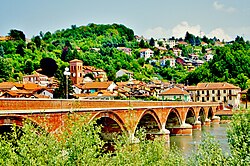Piedmont hills is a territory belonging to Piedmont.
To know
The area includes a large section of southern Piedmont and extends from the central part of the province of Cuneo to the north-eastern part of the province of Alessandria. From west to east, the Piedmontese hilly area includes the territories of Langhe, of the Roero he was born in Monferrato in addition to the hilly territories that surround them. The typicality of the hilly landscapes of Lower Piedmont, characterized by a centuries-old interaction between anthropic crops (the vine first of all), woods and small villages rich in history, has recently allowed Wine Landscapes of Langhe-Roero and Monferrato to be recognized as one of the World Heritage Sites in Italy during the 38th session of the committee UNESCO to Doha.
Territories and tourist destinations


In addition to the territories mentioned above, it is impossible not to describe the Monferrato, a vast territory that includes the whole central part of Piedmont and includes the territories ofAsti he was born in Casalese and, with regards to the Apennine area, L'Acquese, L'Ovada and the Novese. Predominantly hilly territory, it extends south of the Po to the northern slope of the Ligurian Apennines. It is an eminently wine region, renowned for the production of red wines such as Barbera, Dolcetto, Grignolino, Freisa and Ruché, and dessert whites such as Moscato, Asti, Malvasia and Brachetto. The centuries-old cultivation of the vine has left an indelible mark both on the surface, with the large expanses of vineyards interspersed with hazelnut groves, wheat fields and woods, and in the basement, with the infernotti of the Lower Casalese and the "Underground Cathedrals", large historic cellars in the area of Nizza Monferrato is Canelli. The recognition of the Monferrato wine landscape as a World Heritage Site has considerably increased the presence of the UNESCO mark in the area, already attributed to the Sacro Monte di Crea in 2003.
Urban centers
- Turin - The first capital of the Kingdom of Italy, today it is an exceptional cultural, historical, artistic and industrial center. There is the majestic Mole Antonelliana, the Egyptian Museum (second only to that of Cairo), the automobile museum, the Savoia gallery, not to mention the splendid architectural works that can be admired while walking through the ancient center, such as Piazza Vittorio Veneto, the most arcaded square in the world.
- Sunrise - The capital of Langhe, offers exquisite food and wine products, white truffles, collected on the hills above Alba and wines, including Barbera, Nebbiolo, Dolcetto, Moscato. In addition to these culinary treasures, walking through Alba we can admire splendid artistic treasures, such as the Duomo, the town hall and the towers.
- Alexandria - The citadel, the Cathedral, the Marengo Museum, the Palazzo Cuttica Museum, the Piazza della Libertà are just some of the most important monuments and architectural works that can be admired in the splendid historic center built with an elegant Savoy style.
- Asti - Center of the largest wine region of Piedmont, the Monferrato, was an important medieval republic, known as the city of 100 towers, of which 15 can still be admired in the ancient fortified city.
- Bra - City of great historical and cultural interest, the tourist will not go unnoticed by the great architectural masterpieces that it preserves: the sumptuous church of Santa Chiara, the Castle of Pollenzo and the Zizzola that dominates the city from the top of a hill and has become his symbol.
- Casale Monferrato - Important industrial center, for many centuries it was under the dominion of the Gonzaga, and now offers tourists rich architectural works such as the Paleologi castle or the church of Santa Caterina.
- Wedge - Wedged (as the name suggests) between the rivers Gesso and Stura, the city still retains a splendid fortified historic center in which the Cathedral of Santa Maria del Bosco, the civic tower and the spectacular Piazza Galimberti stand out.

